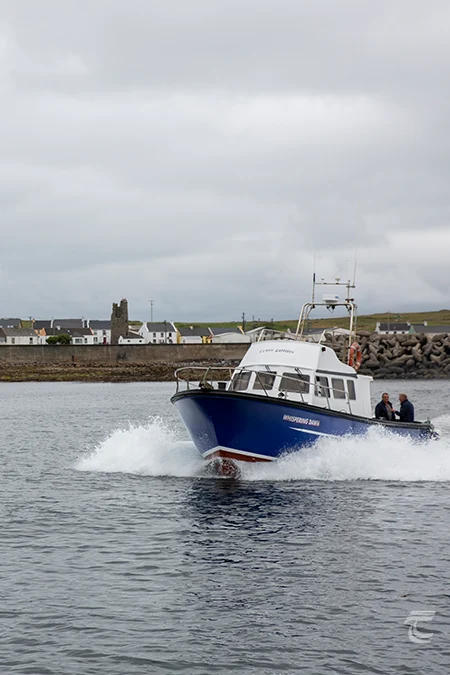Tory Island
Set over 14km off the Coast of Donegal, and surrounded by the tempestuous waters of the Atlantic Ocean, Oileán Thoraí or Tory Island, is the most remote of Ireland’s inhabited islands. The island is small, (at just 4 km2), and home to approximately 120 people. This vibrant Gaeltacht community is famed for its character, its creativity, and its love of music and culture. The renowned artist Derek Hill first visited Tory Island in 1956, and encouraged some of the islanders to take up painting. They developed a distinctive style, becoming known as the ‘Primitives’. The island is also notable for having the Republic of Ireland’s only king. The king, elected by the islanders, acts as the island’s ambassador. The last king of Tory Island, Patsy Dan Rogers, passed away in 2018 and a new one has yet to be elected. An insightful episode of RTÉ Doc on One featured Patsy before his passing, you can hear that here.
Tory Island is an enchantingly beautiful place, where you can find a story around every corner. Perhaps the most famous legend of Tory Island is that of Balor of the Evil-Eye. As his name suggests, Balor possessed an eye of terrible power that had the power to strike his enemies dead with a glance. A druid had prophesied that Balor would be killed by his grandson. To protect himself, Balor had his only daughter, Eithne, imprisoned on the nearly inaccessible rock of Tor Mór at the easternmost end of Tory Island. However even the mighty Balor could not escape fate. Eithne was visited by Balor’s enemy and they fell in love. When he discovered that Eithne had given birth to three sons, Balor was full of fear and fury. He had the three infants flung into a whirlpool, but the eldest, Lugh, survived. When Lugh was a young man, fate was fulfilled when he killed his monstrous grandfather. To this day, Balor’s Fort and Balor’s Prison are names for features on the eastern side of the island.
The craggy coast and otherworldly landscapes of Tory Island are also imbued with tales of the famous saint, Colmcille (also known as St Columba). He was born in Gartan in County Donegal in either AD 520 or 521. Before his death in Iona on the 9th June 593, St Colmcille had become one of the most influential figures in Irish and British history. He was a key catalyst for the spread of Christianity in Northern Britain, and founded monasteries in Iona and Scotland.

The landscape of Tory Island, looking westwards towards the main settlement • Donegal
Colmcille’s links to the island comes primarily from Manus O’Donnell’s ‘Life of Colum Cille’. The story describes how Colmcille, accompanied by Saints Fionán, Dubhthach and Begley, climbed up to the peak of Cnoc na Naomh, the hill overlooking where the ferry leaves for the island today. As they took in the view from the hill, they discussed who would have the honour of converting the people of Tory Island to Christianity. To decide, they each threw their staff as far as they could. Begley’s landed on the mainland, where he later founded the church at Tullaghobegley, Dubhthach’s landed on Inishdooey Island, Fionán’s split the rock near the shore and a waterfall known as Eas Fionán began to pour out, while Colmcille’s crozier landed on Tory, winning him the reward of converting the islanders. His crozier is said to have formed a hollow on Tory’s northeast cliffs.
Following this triumph, Colmcille set out across the Atlantic to claim his prize. However, the ruler of the island, Oilill was not overly enamoured with the prospect of Colmcille as a neighbour and refused permission for him to establish a monastery on the island. Colmcille bargained with Oilill, and made the very humble request for just as much land as his cloak would cover. Not wanting to appear churlish, Oillil agreed, only to be enraged when Colmcille’s cloak magically expanded to cover the entire island. In his anger at being tricked, Oilill unleashed his venomous dog on Colmcille. As the dog bounded towards the saint with venom dripping from his maw, Colmcille made the sign of the cross and commanded the dog to die on the spot, and the dog duly obliged. Seeing this, Oilill fell to his knees and was converted. He granted the island to Colmcille, who founded his monastery there. A rock, known as Cloch an Chú – the Rock of the Hound – is on the shore of the island and is said to bear the footprints of the hound.
The earliest written reference to a church on Tory comes from the Annals of Tigernach, that recorded a church being constructed on the island in AD 621. So whether the story of Colmcille’s arrival on Tory Island nearly a century before is true or not, if you visit the island today, you can find many echoes of an early monastery hidden away among the houses of West Town.
This article will introduce some of the key features of the monastery, and some of the other significant locations around Tory Island.
For practical information about visiting this site Click Here
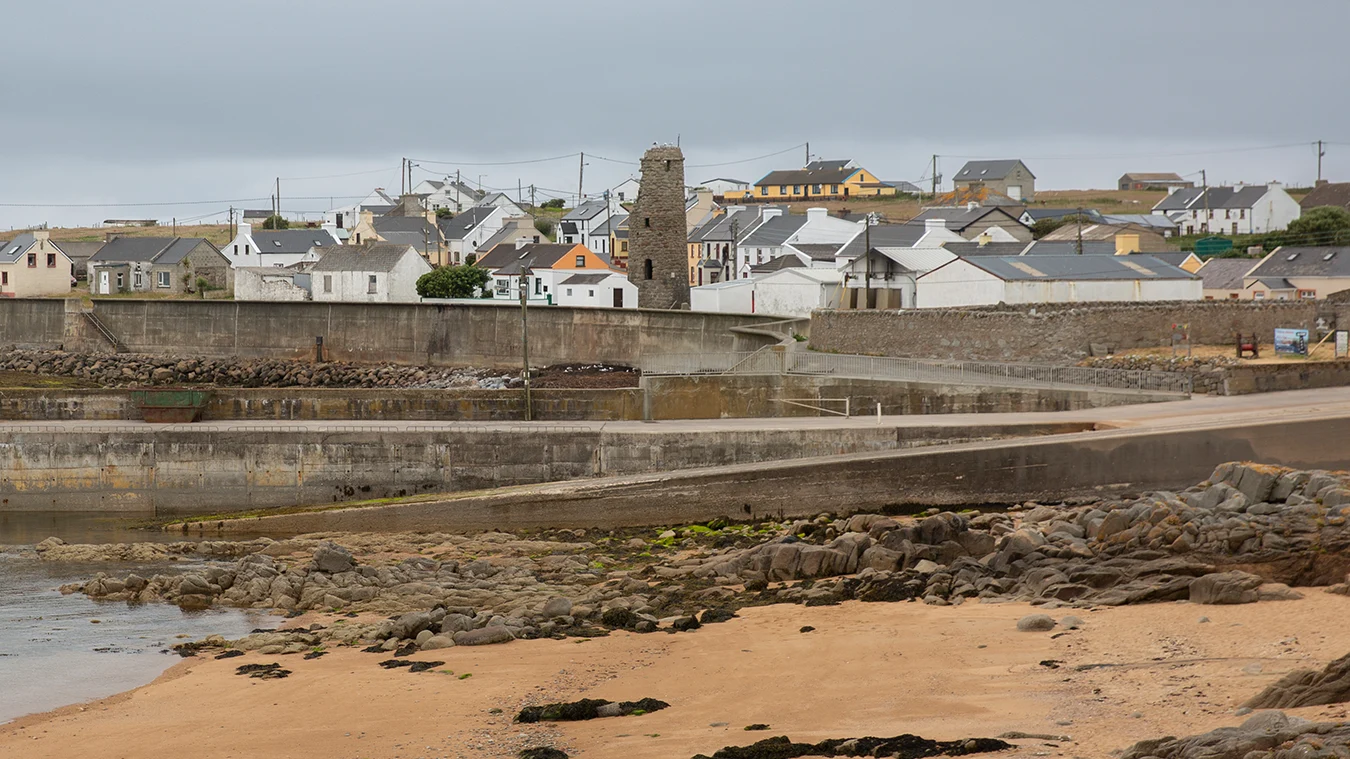
West Town, a place of ancient monuments and modern homes • Tory Island
The Key Features of Tory Island
An Chros Tau • The Tau Cross
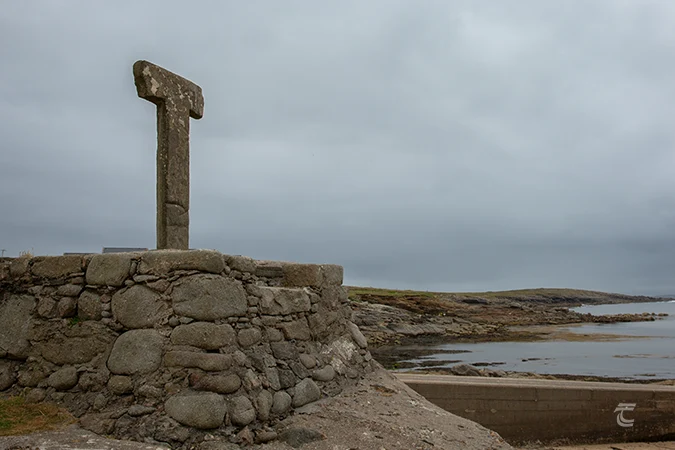
An Chros Tau • The Tau Cross • Tory Island
The Tau Cross is located at the head of the pier at West Town. Named for it’s T-shaped construction, it is one of only two such crosses in Ireland, the other being located at Killinaboy, County Clare. As it is one of the first things a visitor encounters, it has become an iconic symbol of the island. The cross is thought to date to around the 12th century and it is carved from a single block of stone. Interestingly, the stone is mica slate, a rock type not found on Tory Island. As such the cross must have been transported across the Atlantic waves to the island, giving a tantalising glimpse into medieval shipping, transport and logistics as well as religious belief. The cross stands approximately 1.90m high, the shaft is 0.40m wide and 0.15m thick. The head of the cross is 1.10m wide and 0.35m deep. The cross stands on a mortared rectangular stone platform that is presumably not contemporary with the cross. According to tradition Tory fishermen pray before the cross before heading out to sea.

An Chros Tau • The Tau Cross • Tory Island
Teach an Phobail • St Colmcille’s Chapel
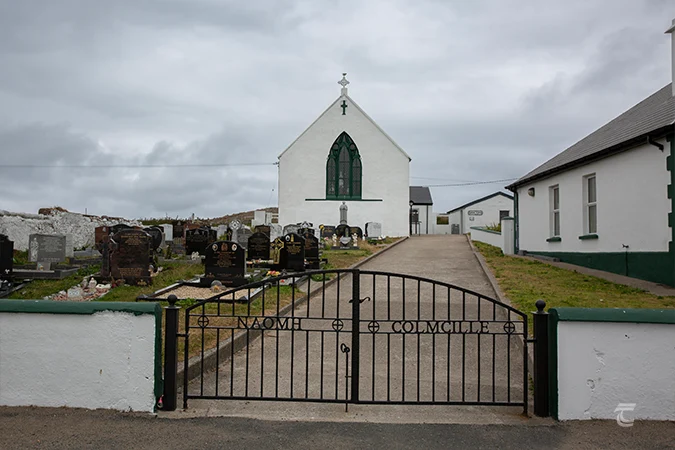
Teach an Phobail • St Colmcille’s Chapel • Tory Island
This atmospheric and well-proportioned chapel was built in 1857 at the cost of £392. It was designed by the English architect E.W. Goodwin, and the stained glass windows are the work of Patrick Pollen. A stone statue to Colmcille stands just outside the chapel. It has a touch of the gothic architectural style, and the charming interior has a carved timber altar and altar rails. The church is surrounded by a graveyard with grave-markers, dating mainly from second half of the 20th century.
An tSean Reilig • The Old Graveyard

Early cross slab and stone fragments • An tSean Reilig • The Old Graveyard
The Old Graveyard of Tory Island is believed to be the location of the early medieval monastery. At the western side of the graveyard, a small stone altar holds a number of stone carvings. These include a cross-slab that is now embedded in the graveyard wall. During a clean-up of the graveyard, islanders discovered a large stone with a slot, later identified by a National Monuments Service archaeologist as being the base of a stone cross. This perhaps provides further evidence that the graveyard lies within the boundaries of the early monastery.

Early cross slab and stone fragments • An tSean Reilig • The Old Graveyard
An Cloigtheach agus Ulaí Eoin Baiste • The Round Tower and St John’s Altar

An Cloigtheach agus Ulaí Eoin Baiste • The Round Tower and St John’s Altar

An Cloigtheach agus Ulaí Eoin Baiste • The Round Tower and St John’s Altar
Constructed from sea-rolled granite blocks, and standing at just 13m high, the round tower at Tory Island is one of the smallest in Ireland, and it is the only round tower that still stands in all of County Donegal. Clog Cholm Cille – Colmcille’s Bell – was hung in the tower until the late-18th century when it was removed after the tower was damaged by lightning. The bell has been missing since the 19th century.
In front of the Round Tower you can see a mortared rectangular platform known as St John’s Altar. The altar is dedicated to St. John the Baptist. A number of architectural fragments and early medieval stone artefacts stand on the platform. Including the top of a stone cross with similarities to St. Oran’s Cross on Iona, and a circular cross-base or mill stone. The artefacts are likely to have been gathered from the immediate area that is thought to have been within the original monastic enclosure. The altar itself appears to be of relatively recent date. It is recorded as a leacht (or drystone altar) that was possibly rebuilt when it was moved from its original position in the early 20th century.
Another small altar known as Ulaí Bhríde, or St Brigid’s Oratory is nearby, hidden away between the islander’s houses in West Town. On top of the altar you can see three quern (or possibly bullaun) stones and what appears to be fragments of graveslabs. Together with St John’s Altar, it may have formed part of a traditional pattern day or island pilgrimage landscape.
Mórsheisear • Church of the Seven
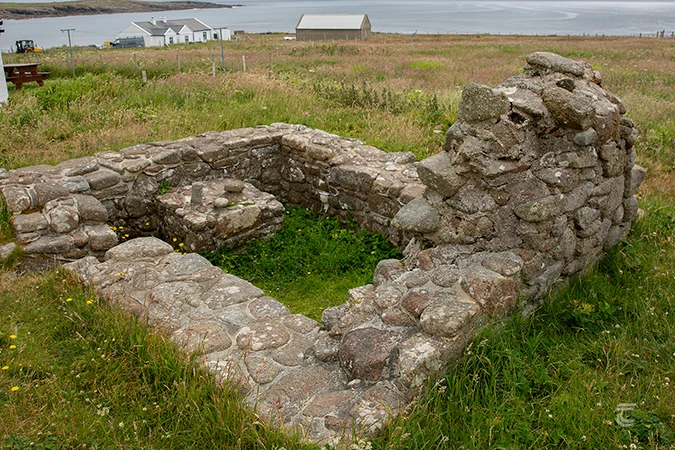
Mórsheisear • Church of the Seven
A small stone chapel located to the west of the town. In Irish it is called Mórsheisear which directly translates as ‘big number six’, an old Irish word for the personal number seven. The name comes from a tale related in Manus Ó Donnell’s The Life of Colum Cille. The text recounts how the story of Colmcille’s piety and wisdom spread worldwide, and so inspired the children of the King of India, six boys and one girl, that they travelled from India to Tory. On coming ashore they died of exhaustion after their long voyage. Colmcille was moved by their devotion, and prayed so that they may be revived, which miraculously worked. The children told the story of their journey and their reasons for travelling. Colmcille sadly told them that they could not escape death, but that he would give them absolution. After receiving their blessing, the children all immediately died.
Colmcille ordered that a stone chapel be built for them, that became known as Teampall an Mhórsheisir, the Church of the Seven. They were all buried in one plot, but in the morning the girl’s body appeared on top of the grave so she was reburied in a separate plot nearby. The chapel survives as a small rectangular foundation of rough blocks. The chapel has a small stone altar at the eastern end, and a bullaun stone is near the entrance. A small walled plot is located nearby to the west. According to folklore this walled plot marks the burial place of the girl. It is said that clay from this plot banishes rats, and the sacred clay is also believed to keep seafarers safe from harm. In order for the clay to be effective, it may only be collected by the oldest member of the Duggan family living on Tory Island.

Mórsheisear • Church of the Seven
Teach an tSolais • Tory Island Lighthouse

Teach Solais • Tory Island Lighthouse

Teach Solais • Tory Island Lighthouse
The lighthouse is set on the easternmost part of Tory Island. It was designed by William Douglass who was best known for his work on the Fastnet Lighthouse off the coast of Cork. It was completed in around 1885, though there may have been an earlier lighthouse from the 1820s on the same site that was incorporated into the existing building. It is well built of local rubble masonry, with a corbelled metal walkway. It is painted in thick bands of black and white. The lighthouse was manned until it was automated in 1990. Next to the lighthouse you can see lighthouse keeper’s cottages. This collection of handsome, formal looking buildings, stand testament to those who built and served in them in this exposed and wild location.
An Reilig Ghallda • The Foreigner’s Graveyard
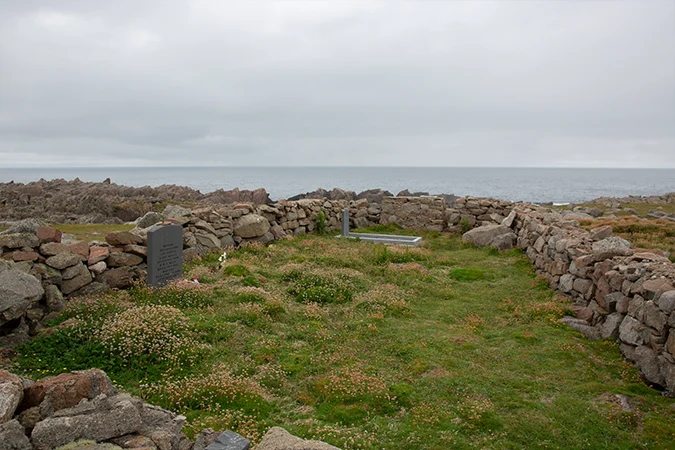
An Reilig Ghallda • The Foreigner’s Graveyard
Around 150m north-east of the compound of the lighthouse, you can see a small walled burial plot. This is known as the Foreigner’s Graveyard. Inside you can see the grave of Sapper William Fullerton who died when U-boat U38 torpedoed his ship on 5 August 1940. In the same plot lie some of the seamen who died when HMS Wasp foundered and sank off the island in 1884. One of the darkest tales of Tory Island, the ship was on the way to carry out evictions when it collided with rocks and sank with the loss of 52 men.
The ship’s loss may have been due to the power of the cursing stone. An account appears in the Irish Times by Frank McNally. Who reports that a Dublin poet, Austin Clarke, who in his 1968 memoir, A Penny in the Clouds, recalled a visit he had made to Tory. He wrote: “I set out for the Cursing Stone. This is a great boulder balanced on the edge of a precipice about 700 feet above the sea, half in half out. In the old days, Lord Leitrim sent out a gunboat, The Wasp, to collect rents that had never been paid, but an old woman went up to the stone and turned it leftways against the sun… The warship sank in the calm waters in sight of the anxious islanders”. The official court martial blamed the loss on the inexperience of the navigating lieutenant. Though the island’s priest took no chances. Appalled by the loss, he pushed the cursing stone over the rugged cliff and into the stormy seas below.

An Reilig Ghallda • The Foreigner’s Graveyard
Dún Balor • Balor’s Fort
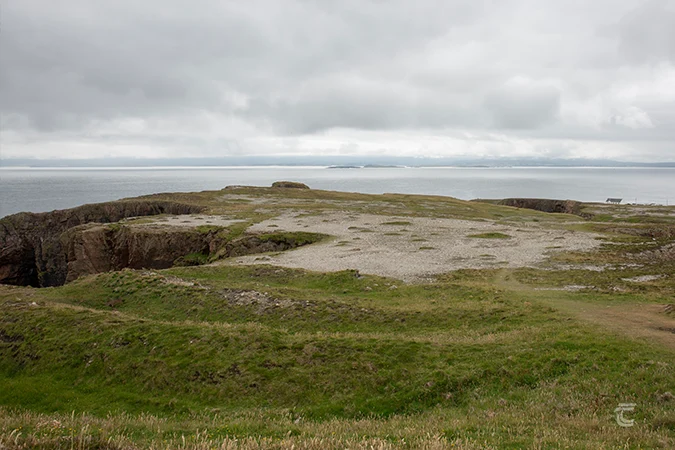
Dún Balor • Balor’s Fort

Dún Balor • Balor’s Fort
There is an interesting concentration of monuments clustered in the far eastern extremity of Tory Island. This is arguably the most beautiful part of the island, and if you are fortunate enough to be there between the months April to August, you can see puffins, which only adds to the allure! Archaeologically, the monuments here can be difficult to see from the ground. Though by far the most prominent is Balor’s Fort, a series of four massive earthen banks with three intervening fosses. This can be seen clearly on satellite view on Google Earth, as a sort of corduroy effect at the narrow point of the promontory before the land broadens out again to the north. This is clearly a promontory fort of some significance, and there are at least twenty foundational remains of hut sites within the protected interior. On the eastern part of this peninsula, a blade-like arm of sheer rock projects out into the Atlantic. It is known as Tor Mór or Balor’s Prison, and though it appears to be completely inaccessible and hostile to any form of human life, there is a defensive ditch crossing the narrow part. Perhaps this was a final refuge at times of great danger. As these have never been radiocarbon dated, it is not possible to state whether all these features are contemporary. Though other excavated promontory forts have produced dates ranging from the Bronze Age into the Early Medieval Period.
A number of low oval shaped mounds of earth and rock can also be seen around this area. They may be the remains of kelp drying platforms. The harvesting of kelp has a long history in Ireland. Kelp had a number of uses, from livestock fodder to fertiliser. From the 18th century, and especially in the 19th century, it became valued for its alkali or soda, that was used in paper making, bleaching, soap and glass production. In the 19th and early 20th century, it was a valuable source of iodine for medical use.
This article merely scratches the surface of this culturally rich and vibrant island. It is well worth making a voyage yourself to experience all that it offers.
Upper left: Derek Hill’s Hut • Lower left: one of the possible kelp-drying mounds • Right: a Tory Island fishing boat
Top: Derek Hill’s Hut • Middle: a Tory Island fishing boat • Bottom: one of the possible kelp-drying mounds




